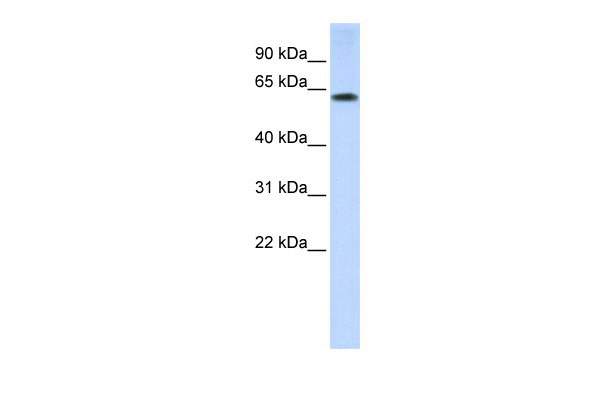TRIM55 antibody - N-terminal region
Rabbit Polyclonal Antibody
- SPECIFICATION
- CITATIONS
- PROTOCOLS
- BACKGROUND

Application
| WB |
|---|---|
| Primary Accession | Q9BYV6 |
| Other Accession | NM_184085, NP_908973 |
| Reactivity | Human, Mouse, Rat, Rabbit, Zebrafish, Pig, Horse, Bovine, Guinea Pig, Dog |
| Predicted | Human, Mouse, Rabbit, Zebrafish, Pig, Chicken, Horse, Bovine, Dog |
| Host | Rabbit |
| Clonality | Polyclonal |
| Calculated MW | 60kDa |
| Gene ID | 84675 |
|---|---|
| Alias Symbol | MURF-2, RNF29, muRF2 |
| Other Names | Tripartite motif-containing protein 55, Muscle-specific RING finger protein 2, MuRF-2, MuRF2, RING finger protein 29, TRIM55, MURF2, RNF29 |
| Target/Specificity | 100% homologous to all four isoforms of TRIM55. |
| Format | Liquid. Purified antibody supplied in 1x PBS buffer with 0.09% (w/v) sodium azide and 2% sucrose. |
| Reconstitution & Storage | Add 50 ul of distilled water. Final anti-TRIM55 antibody concentration is 1 mg/ml in PBS buffer with 2% sucrose. For longer periods of storage, store at 20°C. Avoid repeat freeze-thaw cycles. |
| Precautions | TRIM55 antibody - N-terminal region is for research use only and not for use in diagnostic or therapeutic procedures. |
| Name | TRIM55 |
|---|---|
| Synonyms | MURF2, RNF29 |
| Function | E3 ubiquitin ligase that plays an important role in regulating cardiac development and contractility, muscle growth, metabolism, and fiber-type differentiation. Acts as a critical factor that regulates cardiomyocyte size during development in concert with TRIM63 by regulating E2F1-mediated gene expression (By similarity). Plays a role in apoptosis induction in cardiomyocytes by promoting ubiquitination of the DUSP1 phosphatase. Promotes non-canonical NF- kappa-B signaling and B-cell-mediated immune responses by mediating NFKB2 'Lys-48'-linked ubiquitination and processing. In turn, NFKB2 is further processed by valosin-containing protein/VCP, an ATPase that mediates ubiquitin-dependent protein degradation by the proteasome. May play a role in preventing macrophages from producing inflammatory factors and migrating by downregulating the level of nuclear NF-kappa-B subunit RELA. Also modifies PPARG via polyubiquitination and accelerates PPARG proteasomal degradation to inhibit its activity (PubMed:36737649). |
| Cellular Location | Nucleus {ECO:0000250|UniProtKB:G3X8Y1}. Cytoplasm {ECO:0000250|UniProtKB:G3X8Y1}. Note=TLR4 signaling pathway promotes nuclear translocation. {ECO:0000250|UniProtKB:G3X8Y1} |
| Tissue Location | Highly expressed in muscle. Low-level expression in liver. |

Thousands of laboratories across the world have published research that depended on the performance of antibodies from Abcepta to advance their research. Check out links to articles that cite our products in major peer-reviewed journals, organized by research category.
info@abcepta.com, and receive a free "I Love Antibodies" mug.
Provided below are standard protocols that you may find useful for product applications.
References
Lange,S.,(2005)Science308(5728),1599-1603ReconstitutionandStorage:Forshorttermuse,storeat2-8Cupto1week.Forlongtermstorage,storeat-20Cinsmallaliquotstopreventfreeze-thawcycles.
If you have used an Abcepta product and would like to share how it has performed, please click on the "Submit Review" button and provide the requested information. Our staff will examine and post your review and contact you if needed.
If you have any additional inquiries please email technical services at tech@abcepta.com.













 Foundational characteristics of cancer include proliferation, angiogenesis, migration, evasion of apoptosis, and cellular immortality. Find key markers for these cellular processes and antibodies to detect them.
Foundational characteristics of cancer include proliferation, angiogenesis, migration, evasion of apoptosis, and cellular immortality. Find key markers for these cellular processes and antibodies to detect them. The SUMOplot™ Analysis Program predicts and scores sumoylation sites in your protein. SUMOylation is a post-translational modification involved in various cellular processes, such as nuclear-cytosolic transport, transcriptional regulation, apoptosis, protein stability, response to stress, and progression through the cell cycle.
The SUMOplot™ Analysis Program predicts and scores sumoylation sites in your protein. SUMOylation is a post-translational modification involved in various cellular processes, such as nuclear-cytosolic transport, transcriptional regulation, apoptosis, protein stability, response to stress, and progression through the cell cycle. The Autophagy Receptor Motif Plotter predicts and scores autophagy receptor binding sites in your protein. Identifying proteins connected to this pathway is critical to understanding the role of autophagy in physiological as well as pathological processes such as development, differentiation, neurodegenerative diseases, stress, infection, and cancer.
The Autophagy Receptor Motif Plotter predicts and scores autophagy receptor binding sites in your protein. Identifying proteins connected to this pathway is critical to understanding the role of autophagy in physiological as well as pathological processes such as development, differentiation, neurodegenerative diseases, stress, infection, and cancer.


